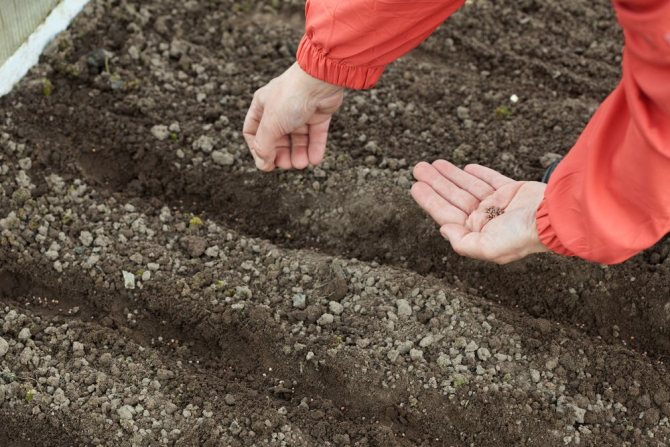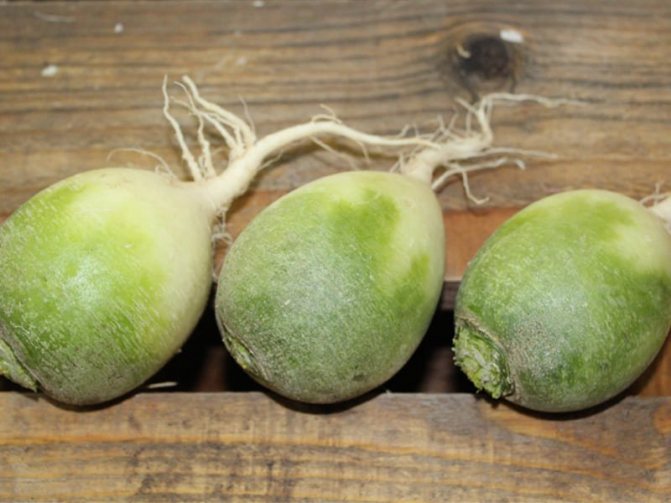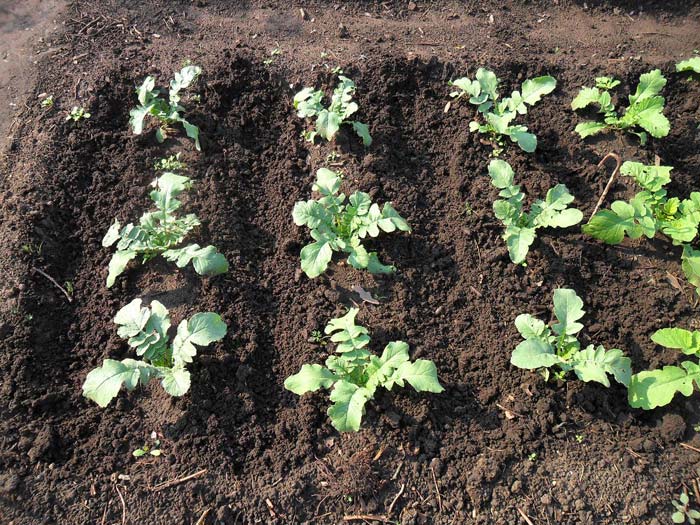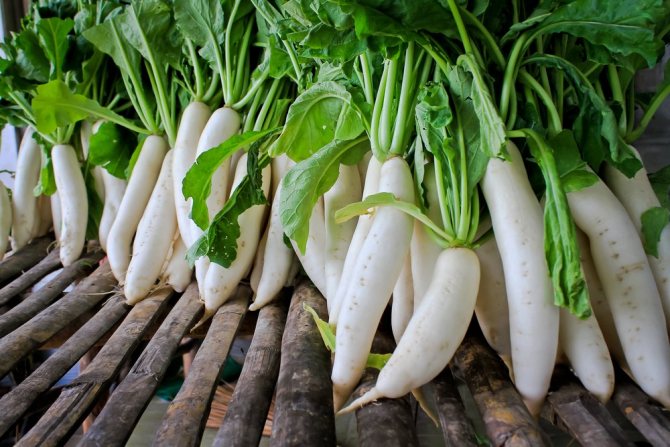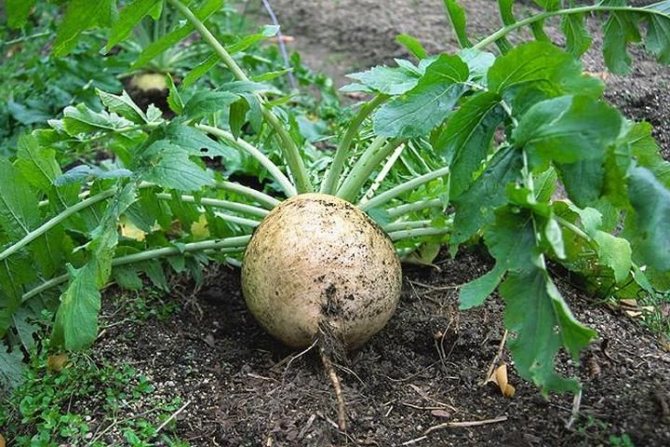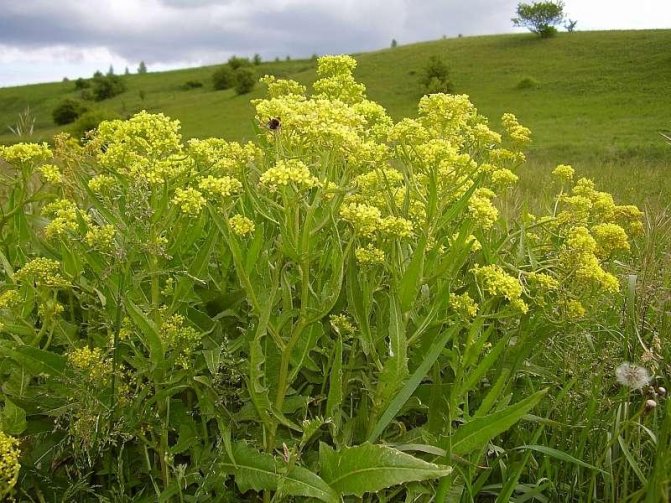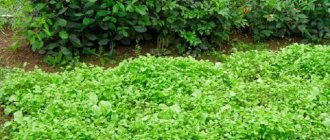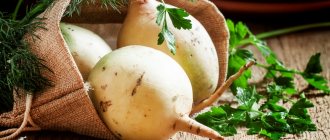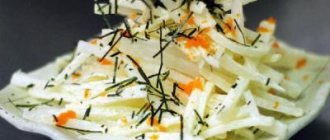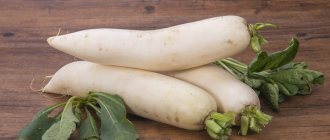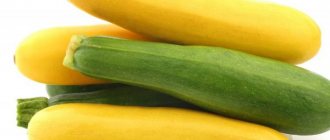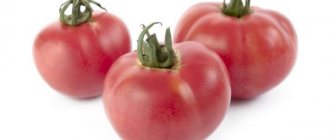Almost all gardeners dream of having easy-to-grow and at the same time useful and, most importantly, tasty vegetable crops on their garden plot. This also applies to the radish, which has long been famous for its beneficial properties. Today we will talk about an extremely tasty and easy-to-care variety - Margelanskaya radish. The following is a detailed description of the variety, features and timing of planting, care, diseases, etc. (photo materials are attached).
Recommendations when to sow Margelan radish in open ground
Margelan radish is one of the varieties of the familiar radish, the Cabbage family. It is also called Lobo or Chinese - this is a two-year-old vegetable that has a rounded or elongated shape, with a predominantly green color, but depending on the variety, it can also have reddish tints. The pulp is mainly transparent green, with slight shades, but there are also more saturated colors. The average weight of one ripe root crop is 0.5 kilograms.
Margelan radish contains a lot of useful microelements for the whole organism, and has a beneficial effect on the digestive system. A distinctive feature from the rest of its brothers is the minimum content of rare oil in the composition, which means that its taste is softer, not pungent and does not "bitter", and it does not irritate the gastrointestinal tract. Many have heard about the beneficial properties of Margelan radish, so it is increasingly found in our beds. Despite the fact that lobo is not a capricious vegetable, in order to get a good and healthy harvest, it is necessary to follow the rules of planting and caring for this crop.
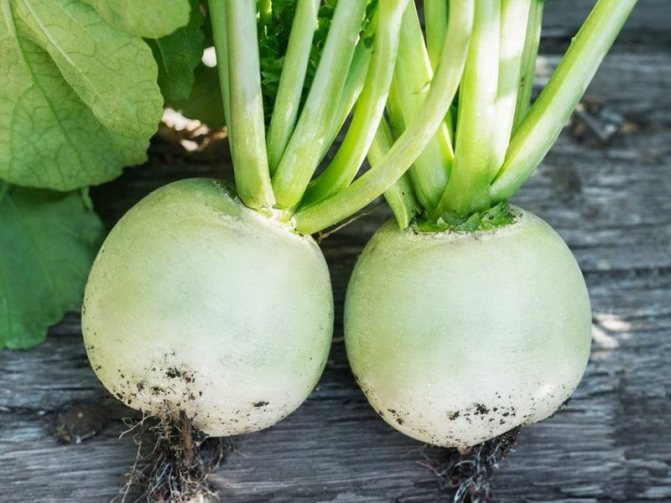
Sowing time of margelan radish
How correctly, basically, we plant all vegetables in the beds in the spring, starting from mid-April. Margelan radish can also be planted during this period of time. But there is one "but". When planting seeds in the ground in spring, there is a high probability that the plantings can bloom, since the air does not warm up enough. And if the Chinese radish has bloomed, then write wasted - all plantings must be uprooted, since they are no longer suitable for food. And the bed will have to be sown again.
The second option for planting Margelan radish is mid-July and further, if weather conditions permit. In this variant, flowering is also possible - if the weather is hot, more than +25 degrees. But, since at the end of July the heat is on the decline, the likelihood of blooming is reduced. The vegetable will tolerate light frosts with ease, and before the onset of cold weather it will have time to gain the prescribed weight and fully ripen.
With a strong desire, a radish harvest can be obtained even twice, by planting it in spring and summer, like a daikon. The summer harvest, as a rule, is eaten immediately, but the autumn harvest is left for storage.


It is noteworthy that the seeds of the Chinese radish begin to germinate already at +4 degrees. And the most comfortable temperature for development is +18 +22.
The ripening time of the Margelan radish depends on its variety - early, mid- or late-ripening. For example, early varieties are ready in about 2 months after germination, but middle and late varieties are ready in 3-3.5 months.And, of course, the weather conditions should not be disregarded.
Preparing the soil for planting Margelan radish
In order to get an ideal harvest - healthy and plentiful, you should take care of the composition of the soil long before planting the seeds, namely, one year in advance.
Lobo loves soil rich in organic matter, but at the same time, the introduction of this organic matter immediately before planting the seeds will negatively affect the growth and development of the root crop. So to speak, "living nitrogen" for Chinese radish means the loss of its taste and useful properties, as well as cracking of the fruit. Therefore, the beds should be fertilized with mullein and compost in the spring of the year preceding the planting of Chinese radish.
If organic matter has not been introduced in large quantities in advance, then in no case should it be introduced before sowing and even in the fall of the previous year. But of course, in the composition of crop rotation on organic beds, this question is not raised.
Also a prerequisite is a slightly acidic or neutral pH of the soil. It is not difficult to check this, and if the acidity of the soil is increased, then measures should be taken to lower it. For example, add lime or dolomite flour to the soil a few weeks before planting.
Before sowing Margelan radish, the selected area must be cleared of mulch and, in case of soil compaction, loosened. In the process of loosening, we also add acidifiers - dolomite or wood ash. If the site lies in a lowland, then it is advisable to raise the beds, at least 10 cm.
To get a rich harvest of lobo, you should also observe the crop rotation, which means that you need to plant the vegetable where before that tomatoes, cucumbers, potatoes, onions, etc. grew. - i.e. exclude cruciferous crops in predecessors.
How to grow margelan radish from seeds
Seeds are carefully selected before sowing - we do not need spoiled, empty and damaged seeds, nothing will grow out of them. Everything that has passed the selection is soaked. You can, of course, do without soaking, then the seedlings will simply appear on the surface of the earth a little later.
First, the bed is watered abundantly, then sowing begins, to a depth of about 2 cm, 2-3 pieces per place. Given the size of the ripe root crop, the distance between the seeds is about 15 cm. But the distance between the rows should be at least 30 cm! After the seeds are laid out, the beds are closed up. You can do without additional watering. After 1.5 weeks (or a little more if the seeds have not been soaked), you can wait for germination.
Seedlings will appear faster if the beds with Margelan radish are covered, and after the sprouts have appeared, the material is removed. You can even throw newspapers on the corners of clothespins so that the wind does not carry away.
When the second leaf appears on the seedlings, the planting must be thinned out for the first time. The second time, thinning occurs when root crops already appear. Here it is necessary to look at the color of the leaves, if they have not acquired a green color, then these crops can be safely removed from the garden. And the last, third time of thinning is when the roots have already reached 5 mm in diameter. Leave only one plant for every 15 cm of the bed, the strongest and healthiest.
When thinning, it is best to pinch off unnecessary plants - if you pull them out, then there is a risk of damaging neighboring sprouts that have not yet matured.
Margelan radish care
As already mentioned, this radish is unpretentious, but nevertheless, it is necessary to carry out some of the points of care.
- Watering. During the ripening period of the Chinese radish root crop, this is the most important point. Abundant watering is vital, because only by getting enough moisture does the radish gain its mass, juiciness and the very taste for which it is loved. If there is not enough water, then the vegetable will be dry, hard and tasteless. Therefore, abundant watering is required.
- Top dressing.The very first feeding is feeding after the first thinning. You just need to sprinkle the beds with wood ash. Also, for better root formation, you can water the beds with weed infusion or a solution of EM preparations. If the soil was well fertilized last year, then you can do only with these dressings. If not, then after about the third thinning, complex organomineral fertilizers are introduced into the soil. And then they look at the composition of the soil: if it is poor, or sandy, then this top dressing is repeated twice. You should not overdo it with fertilizers - there is a risk that the vegetable will accumulate them in its composition.
- Thinning tops. It is imperative to peel off yellowed, broken leaves. Also, you should mercilessly peel off healthy large leaves, which prevent air and light from reaching the garden. By the way, by removing large leaves, we also reduce the risk of blooming, as well as the risk of all kinds of diseases that can easily develop in humidity and darkness.
- Hilling and mulching. Do not forget about weeds - their growth is perfectly contained by mulch. So as the plant rises 7-10 cm, cover all loose soil with organic debris. But if the root crop seemed above ground level, which is absolutely normal for a Chinese radish, then many try to sprinkle it, sprinkling it with soil, otherwise it can supposedly crack and become prey for some pests and slugs. But in our experience, this is not necessary - even protruding root crops ripen perfectly without any damage. But again, it all depends on the climate and soil fertility.
- Pests. The pests of Margelan radish are cruciferous fleas, slugs and cabbage flies, that is, those that parasitize the cabbage family. Therefore, it is important to observe the crop rotation here, and not to plant the lobo in the beds, where all types of cabbage, turnips, mustards, etc. have grown before. To combat pests, the soil around is sprinkled with tobacco dust, crushed needles, and watering is carried out using an infusion of wormwood. But it is best to carry out prevention and do it before planting the Margelan radish in the soil.
Benefit and harm
Chinese or Margelan radish, containing a small amount of calories, cleanses the intestines, speeds up metabolism, removes toxins... The vegetable saturates the body with minerals in the form of:
- potassium and calcium;
- iron and zinc;
- phosphorus and magnesium;
- sulfur and copper.
Selenium and iodine, present in the root vegetable, alleviate the condition of a person with endocrine disorders. Although there are fewer vitamins in this type of radish than in other varieties, they are represented by several groups, including riboflavin, pyridoxine, tocopherol, ascorbic and pantothenic acid. When using a product rich in fiber, pectin, polysaccharides:
- The production of gastric juice is normalized.
- The functioning of the liver is stimulated.
- Bile liquefies.
- Reduces the pain of rheumatism.
Chinese radish helps to eliminate inflammatory processes, disinfects the skin.
Vegetable overuse can lead to unpleasant consequences. The substances present in it give the milk an unpleasant smell, it makes the belly of babies swell from it. Limiting the use of Chinese radish is worth with pancreatitis, ulcers or gastritis of the stomach, with kidney pathologies, with a tendency to allergies.
Pregnant women cannot eat root crops, it is fraught with miscarriage, placental abruption.
Beneficial features
Among the useful properties of Margelan radish, one can note: increased appetite, normalization of digestive processes, elimination of toxins and excess fluid from the body, increased intestinal motility. The vegetable will be useful for people with liver and heart diseases.
Dishes from Margelan radish and its juice can be used as a light natural antiseptic and analgesic, as a cold remedy, to increase the acidity of gastric juice,for removing sand and small stones from the kidneys and bladder. The vegetable has a rejuvenating effect on the tissues of many organs of the body.
Seed preparation
Chinese radish is not very demanding on the soil; many grow it in gardens and summer cottages. If the planting time is correct, the crop can be harvested twice in the summer. Success largely depends on the quality of the seeds; it is imperative to select healthy and large grains. To do this, they are placed in a composition prepared from a quarter glass of salt and a liter of water.
Immediately before planting, the seeds are soaked for a day in a solution of potassium permanganate or for 10 minutes in heated hydrogen peroxide. You can improve the germination of the culture by lowering the grains for 6 hours in an infusion of ash.
Diseases and pests
The culture most often suffers from powdery mildew, is affected by a black leg, and dies from white rot. Careful removal of weeds and excess leaves, digging up the remnants of roots in the fall, adherence to the rules of crop rotation can prevent the development of these diseases. Chinese radish is adored by cruciferous fleas; the culture is affected by the cabbage fly. To protect the plant from these pests, the cultivation of the land with tobacco and ash helps.


Landing
Chinese radish takes root in regions with a sharply continental climate, is unpretentious in care, gives a good harvest of tasty and healthy food.
Landing dates
Plants start sowing when the air warms up to 18 degrees. Chinese radish is sent to open ground in early May, planting is carried out for long-term storage in June.
If the growing season of the crop falls on a period when daylight hours exceed 15 hours, the radish begins to bloom profusely instead of forming fruits. The sowing time should be chosen taking into account the climate of the region.
The soil
A garden bed, matched to a Chinese radish, is dug up on a shovel bayonet in the fall, organic matter and mineral fertilizers are applied. Before planting, fertilize with compost. Fresh manure should be discarded. Sandy soil needs to be fed more.
Landing procedure
Having chosen and prepared a bed for Margelan radish, holes are made in the ground every 15 centimeters. Up to 5 treated seeds are placed in these holes to a depth of 2 cm, soil is poured on top and watered. The seedlings are protected from frost with a film. The distance between the rows of radishes should be at least 50 cm.
To collect 6 kg of juicy root crops from a square meter of a plot, you need to show maximum care for the culture. Margelan radish is necessary:
Without proper care, there will be no good harvest. The culture will lose its resistance to diseases, large root crops will not form.
Thinning
After emergence, the film is removed. When 3 or 4 leaves are formed on the plant, it is necessary to remove the defective shoots, weed out the weeds. Thin the radish repeatedly until one bush remains in each hole. The tops of the fruits, towering above the ground, are sure to spud, otherwise they will become coarse. To ensure the flow of air to the roots, the yellowed leaves and some of the green ones are cut off.
Contraindications
Radish Daikon
Margelan radish, planting and care, the planting dates of which were presented above, is not suitable for everyone. Unfortunately, there are certain contraindications:
- Chronic gastritis, increased acidity;
- Acute phase of peptic ulcer disease;
- Renal dysfunction, urolithiasis;
- At the time of the development of infectious diseases;
- Carrying a fetus and feeding;
- The body's predisposition to non-standard reactions.
All these points are taken into account before they are going to grow healthy Chinese radish on their site.
Harvesting and storage
Root crops react negatively to weather changes, temperature drop.You cannot leave them in the ground until late autumn.
The early varieties are dug up 2 months after the sprouts emerge, the late ones are harvested after 100-110 days. Harvesting takes place in the morning or evening in dry weather. Root crops are pulled out by the leaves, after which they are cleared of the ground.
Without cracks and dents, margelan radish will not deteriorate, will not lose its taste until spring, if stored at zero temperature and high humidity. The vegetable is used in salads, suitable for salting, stewed and pickled. Root crops supply vitamins and minerals to the human body, which are not enough in winter.
Radish is a root crop cultivated for a long time in Russia. Due to its rich chemical composition, yield and ease of care, it is in demand in the national cuisine. Not so long ago, in addition to well-known varieties, gardeners began to plant Margelan radish - a variety brought along the Great Silk Road from China through the Uzbek city of Margilan. Therefore, its other name is Chinese, or Loba.
Margelan radish has a green root vegetable and, unlike the black variety, it has a mild pleasant taste, bitterness is almost completely absent. It is worth finding out what are the features of growing a crop, the timing of planting, the subtleties of caring for it: in order to avoid mistakes and grow a rich harvest of vegetables.
Features of growing Margelan radish in the open field
Landing Lobo is carried out directly into the ground. The timing depends on the climatic conditions of the region and the variety of green radish, which can be both early maturing and for long-term winter storage. To get such root crops, sowing is most often carried out in two terms.
Margelan radish reaches its full maturity in 60 - 90 days. During this time, vegetables turn white-green on top. Juicy crunchy flesh has a pinkish, greenish or white tint. The shape of the root crop is round or cylindrical, its mass, on average, is 400 g.
There are not many vitamins in the composition of Margelan radish, but in terms of the content of minerals it has overtaken other types. Manganese, iron and magnesium are not only contained in it in large quantities, but are also easily absorbed by the human body.
Planting can be carried out on any soil and with insufficient lighting for other crops. In order for the harvest to be worthy, careful care and cultivation of green radish is necessary in compliance with all the rules of agricultural technology.
When purchasing seeds, you need to pay attention to their quality and shelf life. It is necessary to prepare seed material for planting, observe the deadlines. After the emergence of sprouts, care consists in watering, removing weeds, feeding the plants. It is equally important to harvest on time and place the Margelan radish for storage.
Which varieties are more suitable?
Reference. Margelan radish Loba is subdivided into five varieties - white, green, purple-heart, red meat and purple.
In total, 25 varieties of Loba are entered in the State Register, which are recommended for cultivation on personal subsidiary plots in all cultivation zones.
| Consumption period | Varieties |
| Summer |
|
| Late summer | Gourmet breakfast |
| Autumn |
|
| Late autumn |
|
| Winter |
|
Depending on the variety the period from planting to harvest is 55–90 days. Root crops are juicy and sweet, round or cylindrical, weighing from 150 to 500 g. They do not differ in good keeping quality - from 60 to 200 days.
Chinese Loba radish seeds of various varieties from leading Russian producers, packed in 1 g each, costing from 17 rubles, indicating the period of use and supplied with instructions for growing, are purchased in specialized stores. Online stores offer professional weight seeds with delivery.
Planting dates for Margelan radish
Two vegetable crops can be grown per season. The first sowing is carried out at the end of spring. The resulting roots are most often used fresh.In the middle of summer, later varieties of green radish are planted, laid for long-term winter storage.
Most often, in central Russia, it is sown in early May. It is necessary to plant so that the vegetation of the plant does not fall on the longest daylight hours, since with its duration of 15 hours or more, the greener radish does not form a root crop, but begins to bloom violently. The air temperature should be between 18 and 22 oС. At temperatures above or below the values indicated, the plant also forms a peduncle.
These indicators should be guided by when planting, but in each climatic zone they occur at different times.
The second sowing is carried out in the second decade of July, and in the south - in August. The technical maturity of root crops occurs in 2 - 3 months. When calculating the timing of planting, they are guided by the time of the onset of the first frosts and the ripening period of the Margelan radish. The plant tolerates slight cold snaps and frosts, but at low temperatures it begins to bloom, and the root crop does not grow.
Description of the variety
Chinese radish (forehead) of the Margelanskaya variety has been in the State Register of the Russian Federation since 2007. This is a mid-season variety (root crops reach technical ripeness 60-65 days after the shoots appear), it can be grown in all climatic regions of Russia.
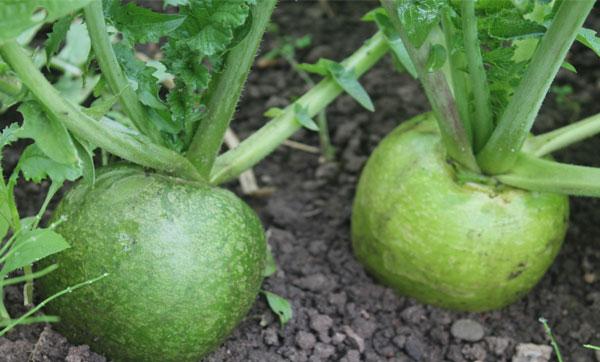

According to the description of the originator from the Margelan radish:
- leaf obovate with jagged edges, medium in size, yellowish-green color;
- the leaves are collected in an upright outlet;
- elliptical roots, with a round head, green skin color, white tail;
- inside the root vegetables of the radish are white or greenish, without bitterness, weakly sharp, the flesh is tender, slightly crunchy;
- taste good.
The yield of the Chinese radish of the Margelanskaya variety is 3-3.5 kg per 1 sq. m with an average root weight of 0.25-0.3 kg. Harvested root vegetables are recommended for fresh consumption.
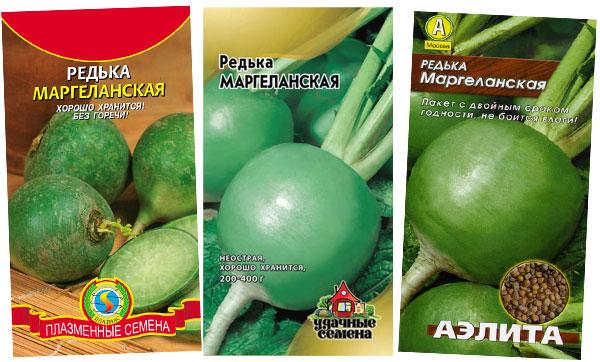

How to grow a Margelan radish
Growing green radish is not difficult even for novice gardeners.
However, you need to know and follow the main stages of planting and growing a vegetable:
- you should not add fresh manure to the soil: it is better to fertilize the soil with compost;
- sowing is carried out in pre-prepared beds in grooves or holes;
- for nesting, 4 radish seeds are placed in each hole;
- after the emergence of seedlings, several thinning is carried out, leaving one plant in the hole;
- regularly watering and feeding;
- if necessary, treat Margelan radish against diseases and pests;
- harvest in a timely manner.
Selection and preparation of the landing site
An open, lighted area is suitable for Margelan radish. The culture does not do well on soils where water is retained. In this case, it is worth making high beds and planting seeds not in grooves, but in a ridge. Otherwise, cracks may appear on the forming roots, into which an infection penetrates, leading to their decay.
The soil should be neutral or slightly acidic. With increased acidity of the soil, it should be limed.
Observance of crop rotation is mandatory when planting Margelan radish. The predecessors can be onions, legumes, tomatoes, cucumbers. You should not plant this vegetable crop after cruciferous plants - cabbage, radishes, turnips, rutabagas.
In autumn, the site is dug to a depth of at least 30 cm, fertilized with rotted compost. On clay soils, it is worth adding organic matter to lighten their structure. It is not recommended to use fresh manure, as it can affect the taste of root crops and the duration of their storage.
Planting rules for margelan radish
Prepare the seeds before planting the radish. For this purpose it is necessary:
- Soak them in a weak solution of potassium permanganate for a day.
- Remove floating seeds.
- Settled to the bottom - rinse and fill with a growth stimulator solution for 12 hours.
In prepared beds with a width of 1.2 m, grooves are made about 2 cm deep at a distance of 30 - 40 cm from each other. Seeds are distributed in them at a distance of 15 cm from each other, 4 pieces each, and covered with a small layer of soil. If planting is carried out by the "nesting" method, then several seeds of Margelan radish are placed in the holes arranged in a checkerboard pattern. The soil should be moist, loose, seeding depth - 2 cm. To accelerate the emergence of seedlings, the garden bed should be watered and covered with non-woven material.
Ripening dates for Margelan radish
Since the culture is quite susceptible to temperature fluctuations and a cold snap can negatively affect the quality of the crop, it is not worth delaying the timing of harvesting Margelan radish.
It will take two to three months for root crops to ripen after planting. Early varieties begin to be harvested after 50 - 70 days and most often they are not put on long-term storage, but are used for food, they make preparations.
Harvesting of Margelan radish of mid-season and late varieties begins 75 - 100 days after planting. Root crops are keeping quality, they can be laid for long-term winter storage.
Specific dates depend on the climatic conditions of the region where the culture is grown. The last autumn harvesting dates for Margelan radish in Siberia, the Urals, the middle lane is the first decade of October. With regular drops in nighttime temperatures, this should be done earlier.
Sowing dates


The timing depends on the soil and climatic characteristics of a particular area and varietal qualities. In the conditions of the Novosibirsk region, favorable conditions for the growth and filling of root crops are formed after June 30.
For the monsoon climate of Primorye, the best varieties are Lobah Raspberry Ball, Elephant Tusk, Harbin. Here, sowing is carried out using a ridge or bed technology in the third decade of July.
The best time for sowing Chinese radish in the Non-Black Earth Region is from the middle of the 1st decade to the 2nd decade of July.
How and when to store Margelan radish
Root crops are harvested after they have ripened. In summer, they are dug in dry and warm weather in the morning or evening. In autumn, harvesting Margelan radish should not be delayed until frost. Although the vegetable is resistant to low temperatures, it can freeze slightly, and after damage it will no longer be suitable for storage.
When harvesting, you should carefully pull the radish out of the soil by the leaves, clean it from the ground, and cut the petioles.
If the soil is dense, and it is not easy to pull out the root crops, then they are carefully dug in and removed from the ground. After cleaning, they are left for a couple of hours to dry, after which they are sorted and sent for processing or storage.
How to store Margelan radish for the winter
According to the timing of planting and ripening, the radish is divided:
Early varieties can be refrigerated for up to three weeks.
For the winter, they leave strong, intact fruits of medium and late ripening. Not quite whole cornfruits are immediately put into processing. They are used to make blanks that are stored in the refrigerator, freezer, cool place.
Whole vegetables are placed in the cellar. In its absence, you can dig a hole 1 m wide and up to 70 cm deep. The bottom is covered with straw, the roots are laid on it in layers and covered with sand. The top is covered with earth and snow (in winter). In such a shelter, Margelan radish is well stored until spring.
How to store Margelan radish in a cellar in winter
In a basement or cellar, not only margelan radish feels good, but other vegetables as well. High preservation is facilitated by temperatures ranging from 2 to 4 oС and humidity of about 80%.
Storing Margelan radish for the winter is possible in boxes installed in several tiers. When vegetables are poured with sand, the percentage of damage decreases.
Wooden bins with a height of 1 m are suitable for root crops, but ventilation holes are required in the walls and bottom of the structures.
How to store Margelan radish at home
Storing Margelan radish on the balcony is possible if the temperature there is not below 0 oС during winter. Vegetables are placed in boxes, sprinkled with sand.
Roots are placed in the refrigerator on a shelf for storing vegetables in plastic bags with several holes.
Longer preservation of the product provides canning, pickling and pickling.
Admirers of Uzbek cuisine often ask themselves: is it possible to freeze Margelan radish for lagman. The answer, most often, is ambiguous, since many note that after freezing, the root crop loses some of its beneficial properties, it ceases to be crispy. But if it is impossible to keep fresh, freezing grated radish is a good way out, especially since after thawing it loses its sharpness and a little bitterness. The lagman cooking technology assumes heat treatment of the vegetable, therefore, the crunchy properties of the radish are deprived in any case.


